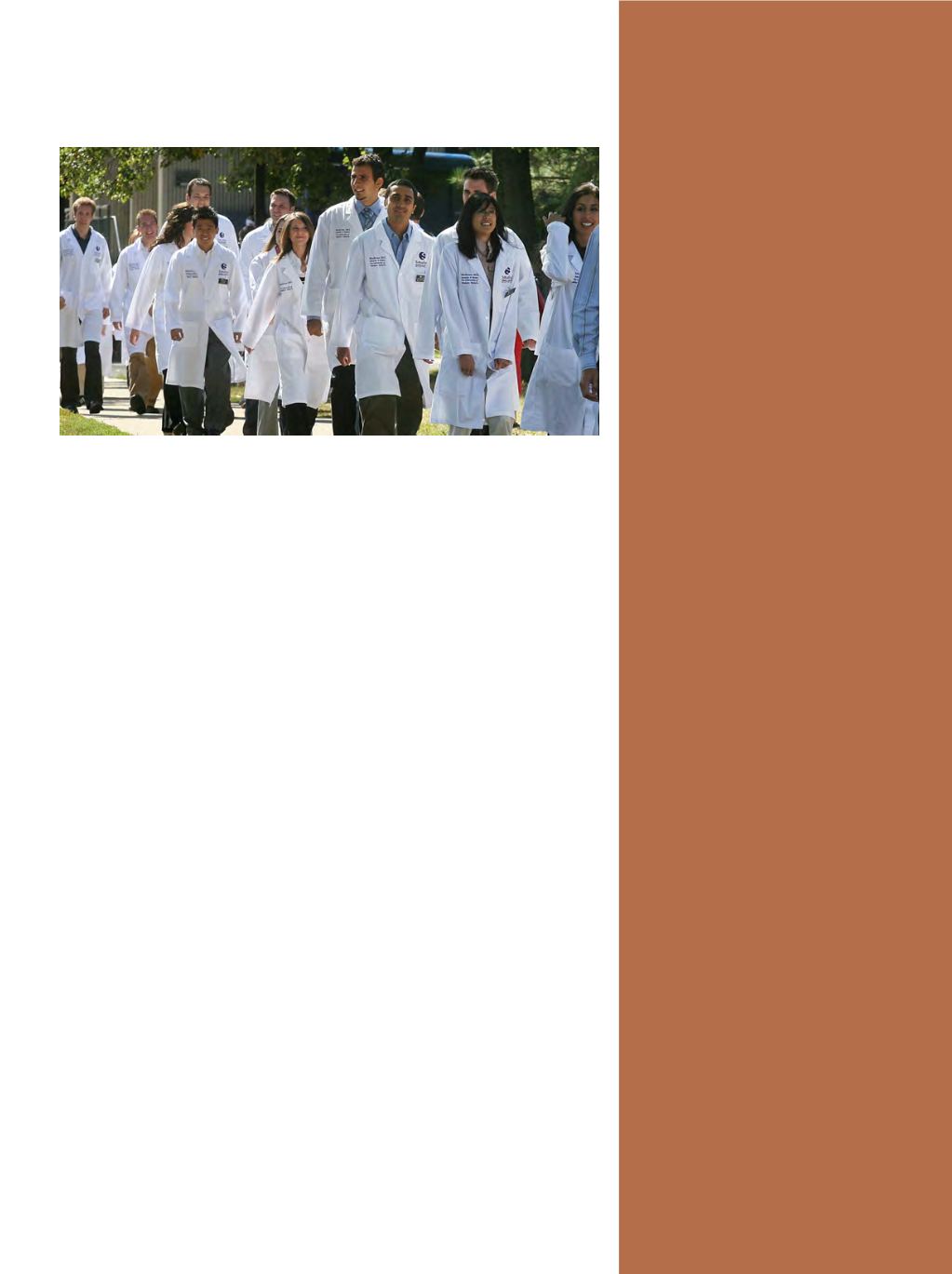
view . fall 2008
15
by the success that Windsor is experiencing.”
In 2006, when the new Schulich School
of Medicine & Dentistry - Windsor Program
was first announced, Windsor-Tecumseh
MPP and Ontario Finance Minister
Dwight Duncan said studies have shown
“average-sized” medical programs, such
as UWindsor’s, can produce up to 5,000
direct and 12,000 indirect jobs in the in the
healthcare field.
Windsor Mayor Eddie Francis adds that
the new program offers some “compelling
input” in convincing companies to invest in the
city. It has, in fact, already inspired dreams of
another local medical partnership: this time
between UWindsor and St. Clair College.
Duncan, at the official welcome for the
Windsor students September 9, said he is
encouraged by early discussions between the
College, University and two city hospitals in
establishing a health-sciences training centre.
UWindsor president Dr. Alan Wildeman
says he sees a role for St. Clair to play in
developing new programs to support a
medical school, such as training students
to work with magnetic resonance imaging
machines.“This is a long-term commitment
and I think it’s really going to make a
difference,” Wildeman says. “I can envisage
a time when it truly will be integrated …
where training and healthcare delivery are
integrated into a really wonderful network.”
For now, however, excited young first-
year students immerse themselves in the
moment. Melissa Tenbergen said she is
pleased to see that her class is evenly split
between men and women.
“I think this is a reflection of the times and
the fact that men and women are becoming
equals in our society,” says the student, who
grew up in Ingersoll, Ont., and completed
a four-year degree in Medical Sciences at
Western before enrolling in the Windsor
Program. “Personally, I have found no divide
between the males and females in my class,”
she says. “We all get along really well and I
am confident we will work together in order to
become great physicians.”
Craig Campagna says his first day as a
medical student confirmed his decision to
come to the UWindsor campus. He likes
the small group as “a new style of class and
learning”, though he acknowledges that it
will take another few sessions before he is
comfortable in that setting.
After the morning sessions, Campagna
organized a weekend trip to Western where
the combined classes could develop a
mission statement and attend a semi-formal.
A little later, students made arrangements to
attend a Detroit Tigers game across the river.
“I have never had any class this tight in my
life,” says Campagna. He says he waited a long
time for this, however, he is home at last.
❍
v
THE EVOLUTION OF A
MEDICAL SCHOOL
•
October 1, 2001 – The province
announces a rural and regional
training network for Southwestern
Ontario, with a key centre for clinical
education in the City of Windsor,
co-ordinated by The University of
Western Ontario and UWindsor, with
funding of $1 million immediately
and $2-3 million each year after that.
The decision follows intense lobbying
by the community for relief of the
chronic shortage of physicians and
surgeons in the region.
•
October 29, 2002 – Dr. Raphael
Cheung is appointed Assistant
Dean overseeing Southwestern
Ontario Medical Education
Network (SWOMEN) Windsor.
He begins recruiting local doctors
for clinical teaching.
•
September 2003 – Fourteen students
in their third year of medical school
start their clerkship training in
Windsor. The numbers would increase
to 24 a year later and 32 in 2005.
•
September 2004 – Dr. Cheung
announces 72 physicians – more
than five times the annual average of
12 – have moved to Windsor, in part
because of the SWOMEN program.
•
February 9, 2006 – Ontario Health
Minister George Smitherman
announces a four-year medical
program at UWindsor.
•
June 28, 2007 – Construction begins
on the $24-million, 61,000-square-foot
Windsor Medical Education Building,
located next to the Toldo Health
Education Centre.
•
September 9, 2008 – the first 24
medical students are officially
welcomed to UWindsor.
August 27 – Windsor’s first 24 medical students take part in a White Coat Ceremony in London with the
rest of the class and receive traditional laboratory coats, symbolizing the professional, social and ethical
responsibilities of becoming a physician.


